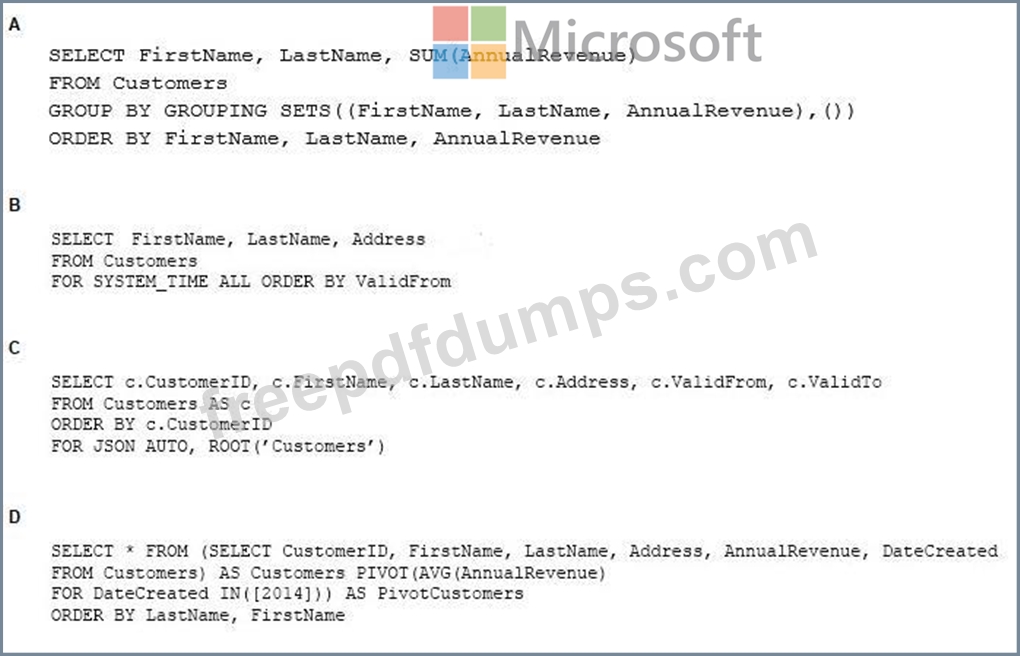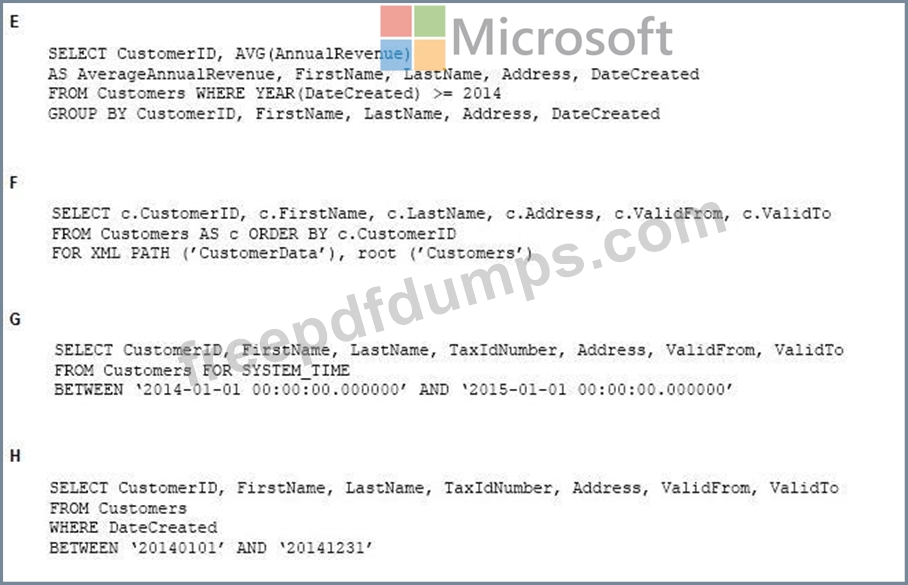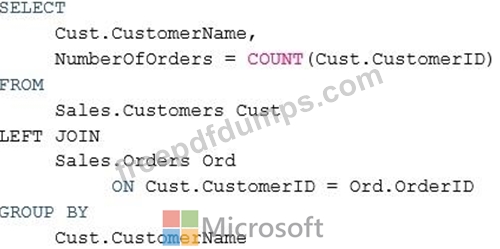070-761 Exam Question 41
Note: This question is part of a series of questions that use the same or similar answer choices. An answer choice may be correct for more than one question in the series. Each question is independent of the other questions in this series. Information and details provided in a question apply only to that question.
You run the following Transact-SQL statement:

You need to return the total annual revenue for all customers, followed by a row for each customer that shows the customer's name and annual revenue.
Which Transact-SQL statement should you run?


You run the following Transact-SQL statement:

You need to return the total annual revenue for all customers, followed by a row for each customer that shows the customer's name and annual revenue.
Which Transact-SQL statement should you run?


070-761 Exam Question 42
Note: This question is part of a series of questions that present the same scenario. Each question in the series contains a unique solution that might meet the stated goals. Some question sets might have more than one correct solution, while others might not have a correct solution.
After you answer a question in this section, you will NOT be able to return to it. As a result, these questions will not appear in the review screen.
You have a database named DB1 that contains two tables named Sales.Customers and Sales.Orders.
Sales.Customers has a foreign key relationship to a column named CustomerID in Sales.Orders.
You need to recommend a query that returns all the customers. The query must also return the number of orders that each customer placed in 2016.
Solution: You recommend the following query:

Does this meet the goal?
After you answer a question in this section, you will NOT be able to return to it. As a result, these questions will not appear in the review screen.
You have a database named DB1 that contains two tables named Sales.Customers and Sales.Orders.
Sales.Customers has a foreign key relationship to a column named CustomerID in Sales.Orders.
You need to recommend a query that returns all the customers. The query must also return the number of orders that each customer placed in 2016.
Solution: You recommend the following query:

Does this meet the goal?
070-761 Exam Question 43
Note: This question is part of a series of questions that present the same scenario. Each question in the series contains a unique solution that might meet the stated goals. Some question sets might have more than one correct solution, while others might not have a correct solution.
After you answer a question in this section. You will NOT be able to return to it. As a result, these questions will not appear in the review screen.
You have a database that contains a single table named tblVehicleRegistration. The table is defined as follows:

You run the following query:

The query output window displays the following error message: "Conversion failed when converting the varchar value 'AB012' to data type int."
You need to resolve the error.
Solution: You modify the Transact-SQL statement as follows:

Does the solution meet the goal?
After you answer a question in this section. You will NOT be able to return to it. As a result, these questions will not appear in the review screen.
You have a database that contains a single table named tblVehicleRegistration. The table is defined as follows:

You run the following query:

The query output window displays the following error message: "Conversion failed when converting the varchar value 'AB012' to data type int."
You need to resolve the error.
Solution: You modify the Transact-SQL statement as follows:

Does the solution meet the goal?
070-761 Exam Question 44
Note: This question is part of a series of questions that present the same scenario. Each question in the series contains a unique solution that might meet the stated goals. Some question sets might have more than one correct solution, while others might not have a correct solution.
After you answer a question in this section, you will NOT be able to return to it. As a result, these questions will not appear in the review screen.
You are building a stored procedure that will be used by hundreds of users concurrently.
You need to store rows that will be processed later by the stored procedure. The object that stores the rows must meet the following requirements:
* Be indexable
* Contain up-to-date statistics
* Be able to scale between 10 and 100,000 rows
The solution must prevent users from accessing one another's data.
Solution: You create a local temporary table in the stored procedure.
Does this meet the goal?
After you answer a question in this section, you will NOT be able to return to it. As a result, these questions will not appear in the review screen.
You are building a stored procedure that will be used by hundreds of users concurrently.
You need to store rows that will be processed later by the stored procedure. The object that stores the rows must meet the following requirements:
* Be indexable
* Contain up-to-date statistics
* Be able to scale between 10 and 100,000 rows
The solution must prevent users from accessing one another's data.
Solution: You create a local temporary table in the stored procedure.
Does this meet the goal?
070-761 Exam Question 45
Note: This question is part of a series of questions that present the same scenario. Each question in the series contains a unique solution that might meet the stated goals. Some question sets might have more than one correct solution, while others might not have a correct solution.
After you answer a question in this section. You will NOT be able to return to it. As a result, these questions will not appear in the review screen.
You have a table named Products that stores information about products your company sells. The table has a column named ListPrice that stores retail pricing information for products.
Some products are used only internally by the company. Records for these products are maintained in the Products table for inventory purposes. The price for each of these products is $0.00. Customers are not permitted to order these products.
You need to increase the list price for products that cost less than $100 by 10 percent. You must only increase pricing for products that customers are permitted to order.
Solution: You run the following Transact-SQL statement:

Does the solution meet the goal?
After you answer a question in this section. You will NOT be able to return to it. As a result, these questions will not appear in the review screen.
You have a table named Products that stores information about products your company sells. The table has a column named ListPrice that stores retail pricing information for products.
Some products are used only internally by the company. Records for these products are maintained in the Products table for inventory purposes. The price for each of these products is $0.00. Customers are not permitted to order these products.
You need to increase the list price for products that cost less than $100 by 10 percent. You must only increase pricing for products that customers are permitted to order.
Solution: You run the following Transact-SQL statement:

Does the solution meet the goal?

